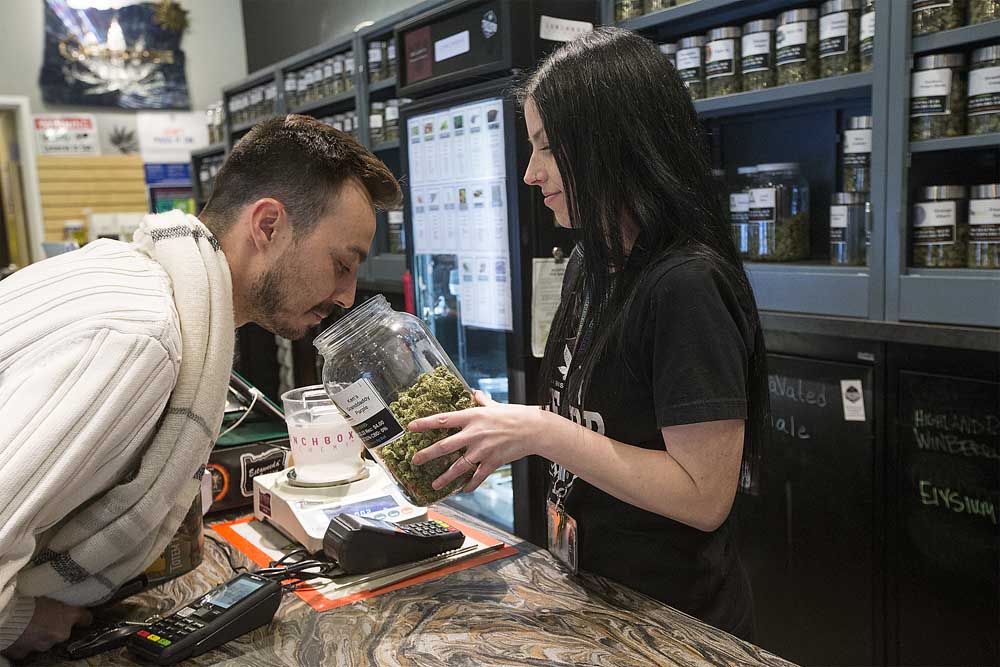Oregon cannabis sales top $790 million last year
Published 12:00 pm Sunday, January 19, 2020

- Stephanie Celorie, floor manager at the Herb Center in Bend, helps Justus Smith with purchasing cannabis.
By SUZANNE ROIG • The Bulletin
Oregon cannabis stores sold $793 million in products to consumers last year, generating more than $110 million in tax revenue for state and county coffers, according to an analysis of Oregon Liquor Control Commission data.
That’s close to $150 million more in sales than 2018. By next year, totals are expected to climb to nearly $1 billion.
The top five counties in terms of legal, recreational cannabis sales to consumers were:
Multnomah $203.9 million
Washington $75.3 million
Lane $70 million
Marion $50.6 million
Deschutes $39.6 million
Source: Oregon Liquor Control Commission
“We think sales will continue to grow,” said Beau Whitney, vice president and senior economist for New Frontier Data, a global analytics firm. “Demand is coming from converting consumers from the illicit market and people moving away from the medical market.”
Recreational marijuana is becoming more acceptable, triggering sales growth year after year in Oregon with no ceiling in sight. The success has allowed Bend cannabis stores to expand in Deschutes County, as well as other major metro areas.
At Tokyo Starfish in Bend, the company’s three outlets experienced a growth in sales in 2019, said Gary Bracelin, store co-owner.
Like other Oregon legal, recreational marijuana companies, 2019 saw some expansion. Earlier this month, Oregrown opened a store in Portland. Tokyo Starfish plans to open another outlet in Salem after it obtains OLCC approval, Bracelin said.
“The future for the industry will be continually growing as cannabis becomes more mainstream and universally accepted,” Bracelin said. “It will continue to attract a wider range of consumers.”
Cannabis sales totaled $648 million in 2018, according to OLCC data. During the same year, the state hit the pause button on processing any new applications for new marijuana grow facilities because there was so much cannabis produced that there was enough to supply the state with more than six years worth of product.
In Deschutes County, there are 36 processors, 78 cannabis producers, or grow sites, and 44 retailers, according to Jan. 13 data provided by the OLCC.
“There are more growers than there were the year before, but just not as rapid a pace,” Whitney said. “Typically, Oregon has a higher percentage of users than say, Alabama. But you’re starting to see other states trying to catch up with Oregon in terms of sales.”
The moratorium for grow operations is good until Jan. 2, 2022, or after the 6½-year surplus of legal, recreational cannabis is consumed.
While Deschutes County racked up nearly $40 million in recreational cannabis sales in 2019, it’s Baker and Malheur counties that are stealing the thunder.
Both of these eastern counties with small populations are selling 10 times more cannabis products per capita to consumers than the state average, said Josh Lehner, senior economist with the Oregon Office of Economic Analysis.
“It’s strong growth because of social acceptance and consumer usage,” Lehner said. “The revenue was stable, but we had price shifts, and that increased volume.”
In Baker County, which has a population of 16,820, according to Portland State University Population Research Center, the per capita cannabis consumption was $3,000 until mid-year, when Malheur County began selling recreational cannabis in Ontario. The full-year average ended at $2,100 per capita for Baker County.
Both counties border Idaho, a state that has not legalized recreational marijuana use. Similarly Malheur County, which began selling recreational marijuana in July, now sells $2,500 worth of cannabis per capita, Lehner said.
In economic terms this is the so-called border effect, he said.
“Baker County dropped once Malheur County sales came online,” Lehner said. “There’s a lot of outside demand. These cross-border effects are very pronounced particularly with vice purchases like tobacco, alcohol and cannabis.”
Cross-border sales could explain the high volume in Baker and Malheur counties, Whitney said.
“These low-population communities also have a low number of recreational retail cannabis stores so demand may be coming in from other jurisdictions that are either opt-out or do not have access to the regulated market,” Whitney said.
At the start of 2019, prices were depressed for cannabis flower products, Whitney said. But by the end of the year prices rebounded, and the number of OLCC licenses has continued to climb.
“Last year was our biggest year yet, for sure,” said Brad Wehde, general manager at The Herb Center on NE Division Street in Bend. “Our sales were roughly a 25% improvement over the year before.”
With 2,800 square feet of space, The Herb Center is among the largest retail outlets in Bend. Each day about 500 customers come into the store. It has more than 1,000 products and has shelf space for 130 different cannabis strains, Wehde said.
“Prices have come back from what they were, but there’s still a lot of instability in the market,” he said. “The OLCC needs to stay out of the business and let the free market reign. Then prices should stabilize.”






